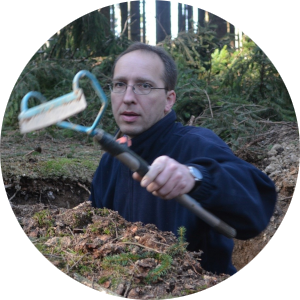You would like to join us and contribute as a scientist or institution? Have a look at our community activities or be part of FAIRagro by submitting a new use case.
Sie suchen Informationen zum FAIRagro Community Summit?

Have a look at our use cases
Use case 1
Exploiting genotype × location × year × management interactions for sustainable crop production.
Use case 2
Assessing tradeoffs for optimal crop nitrogen management
Use case 3
Streamlining pest and disease data to advance integrated pest management
Use case 4
Learning from incomplete data
Use case 5
Noninvasive phenotyping with autonomous robots
Use case 6
Automated data flows for crop simulation models
Statements of data users and providers from the scientific community
- Dr. Gritta Schrader (JKI)
 I prepare and coordinate statutory plant health risk analyses at the Julius Kühn Institute for National and International Plant Health. An important topic of my research is the assessment of the risk of introduction and spread, the pest potential and the impact of plant pests including invasive alien species on plant health and biodiversity. The… Read more: Dr. Gritta Schrader (JKI)
I prepare and coordinate statutory plant health risk analyses at the Julius Kühn Institute for National and International Plant Health. An important topic of my research is the assessment of the risk of introduction and spread, the pest potential and the impact of plant pests including invasive alien species on plant health and biodiversity. The… Read more: Dr. Gritta Schrader (JKI) - Prof. Dr. Jens Karl Wegener (JKI)
 The current challenges in agriculture can probably only be overcome with overall systemically oriented solutions. With Spot Farming, the JKI has developed a new crop production concept that shows what future sustainably intensified crop production could look like, taking social and ecological concerns into account. In order to turn Spot Farming from a concept into… Read more: Prof. Dr. Jens Karl Wegener (JKI)
The current challenges in agriculture can probably only be overcome with overall systemically oriented solutions. With Spot Farming, the JKI has developed a new crop production concept that shows what future sustainably intensified crop production could look like, taking social and ecological concerns into account. In order to turn Spot Farming from a concept into… Read more: Prof. Dr. Jens Karl Wegener (JKI) - Dr. Sabine Seidel (Uni Bonn)
 I work at the University of Bonn as the head of a junior research group in the DFG Cluster of Excellence PhenoRob and am involved in field trials on, among other things, mixtures, resource efficiency and ecosystem services. I am also involved in the Dikopshof continuous fertilization trial. In this respect, I have links to… Read more: Dr. Sabine Seidel (Uni Bonn)
I work at the University of Bonn as the head of a junior research group in the DFG Cluster of Excellence PhenoRob and am involved in field trials on, among other things, mixtures, resource efficiency and ecosystem services. I am also involved in the Dikopshof continuous fertilization trial. In this respect, I have links to… Read more: Dr. Sabine Seidel (Uni Bonn) - Dr. Einar Eberhardt (BGR)
 FAIRagro is an exciting initiative that represents a tremendous opportunity for agrosystems research. Soils and their data are not only a window into agricultural use over the past 10000 years, but they are also urgently needed to guide and improve future use. Soil data, the basis of many groundbreaking academic studies, have been collected and… Read more: Dr. Einar Eberhardt (BGR)
FAIRagro is an exciting initiative that represents a tremendous opportunity for agrosystems research. Soils and their data are not only a window into agricultural use over the past 10000 years, but they are also urgently needed to guide and improve future use. Soil data, the basis of many groundbreaking academic studies, have been collected and… Read more: Dr. Einar Eberhardt (BGR) - Prof. Dr. Ingrid Kögel-Knabner (TUM)
 Soil is an important production factor in agriculture and is under strong pressure. We have the ability to affect the various soil functions such as storage, filtering, habitat and the impact of soil on climate change. At my institution, we study soil organic matter using the most advanced methodologies. In doing so, we generate excellent… Read more: Prof. Dr. Ingrid Kögel-Knabner (TUM)
Soil is an important production factor in agriculture and is under strong pressure. We have the ability to affect the various soil functions such as storage, filtering, habitat and the impact of soil on climate change. At my institution, we study soil organic matter using the most advanced methodologies. In doing so, we generate excellent… Read more: Prof. Dr. Ingrid Kögel-Knabner (TUM) - Prof. Dr. Annette Prochnow (ATB)
 As the coordinating institution of the Leibniz Innovation Farm for Sustainable Bioeconomy which is being implemented as an interdisciplinary research infrastructure on a practical agricultural farm, we at ATB are really looking forward to applying the solutions which will be set forth by the FAIRagro consortium: FAIRagro is addressing challenges that all research institutions in… Read more: Prof. Dr. Annette Prochnow (ATB)
As the coordinating institution of the Leibniz Innovation Farm for Sustainable Bioeconomy which is being implemented as an interdisciplinary research infrastructure on a practical agricultural farm, we at ATB are really looking forward to applying the solutions which will be set forth by the FAIRagro consortium: FAIRagro is addressing challenges that all research institutions in… Read more: Prof. Dr. Annette Prochnow (ATB)
FAIRagro
If you are interested in our initiative, would like to actively participate or have any questions, please contact us.



